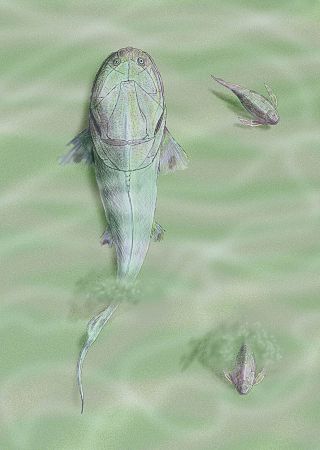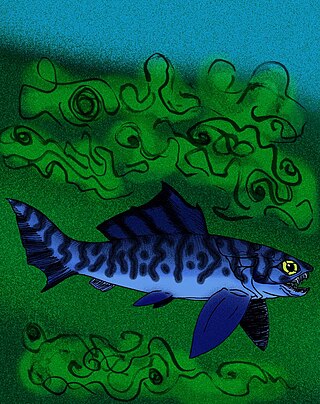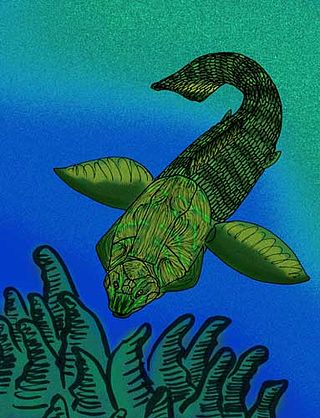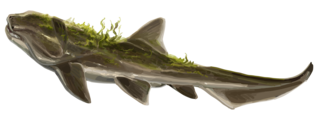
Titanichthys is an extinct genus of giant, aberrant marine placoderm from shallow seas of the Late Devonian of Morocco, Eastern North America, and possibly Europe. Many of the species approached Dunkleosteus in size and build. Unlike its relative, however, the various species of Titanichthys had small, ineffective-looking mouth-plates that lacked a sharp cutting edge. It is assumed that Titanichthys was a filter feeder that used its capacious mouth to swallow or inhale schools of small, anchovy-like fish, or possibly krill-like zooplankton, and that the mouth-plates retained the prey while allowing the water to escape as it closed its mouth. A study has since confirmed this assumption as its jaws are functionally closer to that of filter feeders like baleen whales and basking sharks, and it appears to have developed from benthic durophagists that became pelagic suspension feeders. This would make it the first (known) large-sized vertebrate filter feeder. Titanichthys was estimated to have reached a length of 7–7.6 m (23–25 ft), but Engelman (2023) suggested that Titanichthys was comparable in size to Dunkleosteus, likely measuring about or just over 4.1 metres (13.5 ft) in length.

Homosteus is a genus of flattened arthrodire placoderm from the Middle Devonian. Fossils are found primarily in Eifelian-epoch aged strata of Europe, Canada, Greenland, and Estonia. All of the species had comparatively large, flattened heads with, as suggested by the upward opening orbits, upward-pointing eyes. These adaptations suggest that the various species were benthic predators. A study on Titanichthys, in contrast, suggests that species of Homosteus may have been filter-feeders instead.

Holonema is an extinct genus of relatively large, barrel-shaped arthrodire placoderms that were found in oceans throughout the world from the Mid to Late Devonian, when the last species perished in the Frasnian-Fammian extinction event. Most species of the genus are known from fragments of their armor, but the Gogo Reef species, H. westolli, is known from whole, articulated specimens.

Pseudopetalichthys problematica is a lightly armored pseudopetalichthyid placoderm from the Hunsrückschiefer Lagerstätte of Early Devonian Germany. The holotype and only known specimen is an articulated, but incomplete individual consisting of a large, mostly intact, plate-covered head, the bases of the pectoral fins, and most of the vertebral column, with a total length of 15 centimetres (6 in). The specimen superficially resembles Stensioella, though the structures of the mouth, and orbits, and placement of the gill rakers all differ.

Quasipetalichthys haikouensis is the type and only known species of the extinct petalichthid placoderm, Quasipetalichthys. Fossil remains of Quasipetalichthys have been found in the Middle Devonian, Givetian faunal stage of China.

Hadrosteidae is a family of arthrodire placoderms from the Late Devonian. It was originally erected for the late Frasnian Hadrosteus, from the Kellwasserkalk facies. Later, the family was subjectively subsumed into Dinichthyidae due to Hadrosteus' anatomical similarities with Dunkleosteus and Dinichthys. In 1967, Obruchev placed the enigmatic arthrodire incertae sedisDiplognathus, from the Eastern American Famennian, within Hadrosteidae, on the basis of how the two genera have similar denticle ("teeth") patterns of the inferognathals, though, Denison (1978) contests this placement. With the redefining of Dinichthyidae as a monotypic family for Dinichthys, and only a few other genera placed within Dunkleosteidae, Hadrosteidae is now seen as a valid family again.

Hadrosteus is an extinct monospecific genus of large arthrodire placoderm from the Late Frasnian Kellwasserkalk facies of Bad Wildungen, Germany. It had large, double-pronged inferognathals, and serrated edges along its mandible, strongly suggesting that it was a fish-eating predator. The head had a triangular snout, and the trunkshield was short, but high, with a median dorsal plate that was broader than wide. The average skull length is about 16 centimeters.

Diplognathus is a genus of arthrodire placoderm from the Late Famennian Cleveland Shale of Late Devonian Ohio, known only from incomplete fragments of jaws and skulls. What fragments are known suggest that the living animals were large-eyed piscivores with weak, but widely gaping jaws. D. mirabilis is thought to be fairly large, with infragnathals up to 45 centimeters in length. The second species, D. larfargei, was much smaller, with inferognathals averaging about 4 centimeters in length.

Holonematidae is an extinct family of relatively large arthrodire placoderms from the Early to Late Devonian. Almost all fossil specimens are of armor fragments, though, all have distinctive ornamentation, often of unique arrangements and patterns of tubercles, that are diagnostic of the family. The trunkshield is very elongated, giving the armor an overall "barrel" like appearance.

Neopetalichthys yenmenpaensis is an extinct petalichthid placoderm from the Early Devonian of China.

Paraplesiobatis heinrichsi is a lightly armored pseudopetalichthyid placoderm from the Hunsrückschiefer Lagerstätte of Early Devonian Germany. The type and only known specimen is an articulated, but very incomplete individual consisting of a large, incomplete, plate-covered head, and some of the vertebral column, with a total length of 10 centimeters. The specimen strongly resembles Pseudopetalichthys to the point that many experts suggest they may be of the same genus or species, though because the only specimens of both genera are so poorly preserved, talk of synonymizing the two can not begin until more, better preserved specimens are found.

Nessariostoma granulosum is a lightly armored pseudopetalichthyid placoderm from the Hunsrückschiefer Lagerstätte of Early Devonian Germany. The type and only known specimen is an articulated, but very incomplete individual, deformed and elongated, consisting of a large, incomplete, tubercle-covered head, a long, beak-like rostrum, and some of the trunk, with a total length of 18 centimeters. N. granulosum was once placed in Stensioellida, though most other experts regard it at as a pseudopetalichthyid: Denison 1978 regards it as a placoderm incertae sedis because the specimen is deformed and so poorly preserved so as to stymie proper attempts at classification.

Belemnacanthus giganteus is a large, extinct, barrel-shaped holonematid arthrodire placoderm from Givetian-aged strata of Middle Devonian Eifel, Germany. B. giganteus is known only from the holotype, a 37 centimetres (15 in) portion of a median dorsal plate with a long, somewhat high, arching crest running down the median line of the exterior/dorsal side of the plate. The plate has an ornamentation of ridges that originate from a point posterior to the preserved portion of the median dorsal plate. Before the plate was identified as that of a holonematid, the plate of B. giganteus had been successively described as a tremendous spine of an elasmobranch, an agnathan, and lastly, the plate of an antiarch.

Tropidosteus curvatus is a large, extinct holonematid arthrodire placoderm from the Givetian-aged Crinoidenmergel stratum of Middle Devonian Rheinland, Germany. T. curvatus is known from primarily from a slender, 42 centimeter long, arched median dorsal plate, where the two sides meet at a sixty to ninety degree angle, which would have given the live animal a humped appearance. The median dorsal plate is very similar to the median dorsal plates of Rhenonema and Belemnacanthus, and is the primary reason for T. curvatus' placement within Holonematidae. After stating this reason, Denison, 1978, then questions Tropidosteus' placement within the family, noting that the dorsal plate lacks ridged ornamentation, which is a key diagnostic trait of the family. The ornamentation otherwise consists of an external covering of small tubercles.

Protitanichthys is an extinct genus of comparatively large coccosteid arthrodire placoderms from the Middle Devonian of the eastern United States. Fossils are found primarily in the Eifelian-epoch aged Delaware Limestone of Ohio, and the Lower Givetian-aged Rockport Quarry Limestone of Michigan

Homostiidae is a family of flattened arthrodire placoderms from the Early to Middle Devonian. Fossils appear in various strata in Europe, Russia, Morocco, Australia, Canada and Greenland.

Heterosteidae is an extinct family of moderately large to giant, flattened, benthic arthrodire placoderms with distinctive, flattened, triangular skulls that are extremely broad posteriorly, but become very narrow anteriorly.

Aspidichthys is a genus of large, distinctively tuberculated arthrodire placoderm of uncertain affinities from Upper Devonian marine strata in the Eastern United States and Europe.

Angarichthys hyperboreus is an extinct homostiid arthrodire placoderm from the Middle Devonian of Siberia. It is known from an infragnathal plate, an intero-lateral plate, and a marginal plate found from the Middle Devonian strata of the Tynep Series formation, in the Bakhta River basin, Tunguska Plateau. A. hyperboreus differs from Homosteus in that the former's marginal plate has a ridge where the central plate would have overlapped it, and in the infragnathal, which is curved sigmoidally, and bears at least seven tooth-like prongs nearer to the functional anterior end.

Heterosteus is an extinct genus of heterosteid placoderm of the Middle Devonian known from remains discovered in Europe and Greenland. According to Denison, 1978, Heterosteus might have been planktivorous, along with Homosteus, and Titanichthys.


























